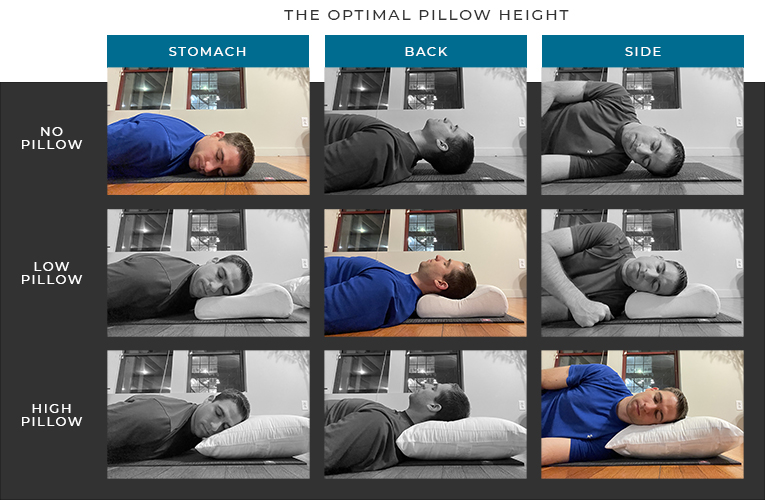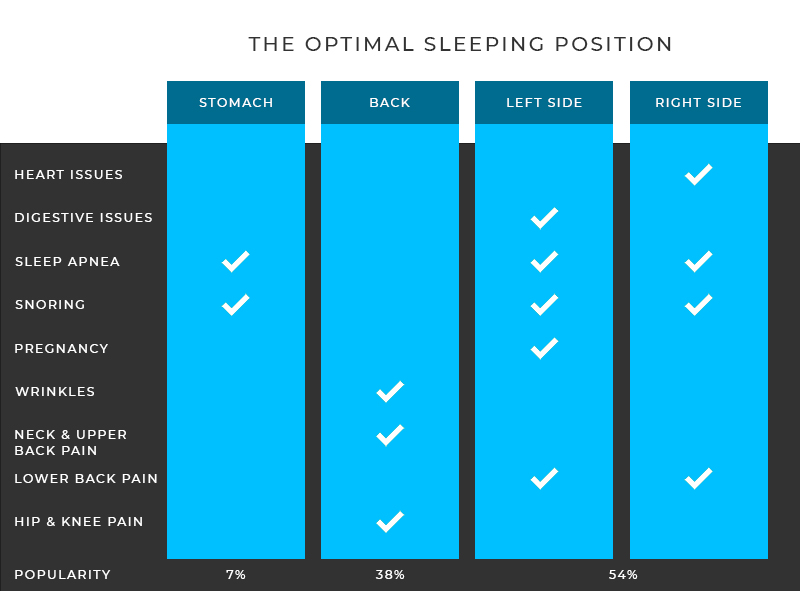So, you’re interested in optimizing your sleep. To wake up feeling refreshed and energized. To start your day without aches, pains, and tight joints. To jumpstart your morning into a productive, motivation filled, running on all cylinders joyous filled day! And you’re willing to look through every article, study, and journal to find every tip, trick, and best practice to do so. And you began to wonder how your sleep posture effects your health and happiness. What role does spending one-third of your life in one static position have on your circulation, digestion, and breathing. What the heck is optimal sleep posture and how can you achieve the perfect spinal alignment to prevent disease, death, and disability all while fostering abundant health and happiness?!
Ok so maybe that wasn’t your exact line of thinking, but it was close to mine. And in doing so, I decided to research everything I could about proper sleep posture and its effects on our overall health and happiness. So, here’s what I found out.
Stomach Sleepers
About 7% of people report sleeping on their stomach or in the prone position. And I’ll start off by saying this… not great, Bob. There wasn’t a lot of benefits I could find about stomach sleeping but there were a lot of negatives. One of the only benefits of being a stomach sleeper is that this position keeps your airways cleared. By lying face down, you reduce the possibility of your tongue or soft palate blocking your airway. This then reduces your chances of snoring or having sleep apnea which is a major problem.
Sleep apnea is a disorder where your breathing repeatedly stops and starts throughout the night and it’s quite common. About 25% of men and 10% of women have sleep apnea and many people have it without knowing it. It’s a condition that can cripple your sleep quality while significantly raising your risk for type 2 diabetes, daytime fatigue, and heart problems. Luckily, maintaining a healthy weight will solve many occurrences and supplementing that with a healthy lifestyle and a proper sleep posture will solve most occurrences. And sleeping on your stomach is one way to help with this issue.
Besides the snoring and sleep apnea benefits, there aren’t many more for stomach sleepers. It’s the worst position for pregnant women. It can cause immediate death for babies due to suffocation. And it puts the spine in poor alignment often causing back and neck pain. On top of that, your face is smushed into the bed or pillow all night which can lead to wrinkles. Because of this, I can’t recommend sleeping on your stomach.

Back Sleepers
About 38% of people report sleeping on their back or in the supine position. This position is much better for you than your stomach except for one serious flaw. Let’s start with the benefits. This position keeps your spine in almost optimal alignment, which is the best at reducing hip, knee, upper back, and neck pain. It’s not the best for lower back pain because there isn’t support for the curvature in your lumbar spine, but this issue can be mitigated by placing a small pillow underneath your knees. It’s also the best position for preventing wrinkles as gravity is pressing your skin equally into your supporting bone structure or face and you’re not pressed into a pillow. But the problem with back sleeping is what was solved with stomach sleeping. It’s the worst position for your airways and most likely to cause sleep apnea and snoring. And the worst part about this disorder is that you may have it without knowing it. One of the only ways to identify it is by having a partner watch you sleep or having a sleep study done. Without these, your sleep quality and life may be suffering significantly without you even knowing it. While I see valid reasons for back sleepers who don’t suffer from snoring or sleep apnea, it’s not my preferred choice solely because of the risk I could develop a disorder and not realize it.

Side Sleepers
About 54% of people report sleeping on their side or in the lateral position. And I’d say, most people have this correct as it’s the position with the most benefits and least downsides. It’s the best position for people suffering with lower back pain. It’s a solid position for the hips and knees as well if you place a pillow between your legs/knees which I recommend. And it’s not bad for the upper back, shoulders, and neck with the proper pillow choice. Sleeping on your left side is the best position for people with digestive issues like GERD and for pregnant women while sleeping on your right side is the best position for blood circulation and heart issues. And either side has been shown to be beneficial for snoring and sleep apnea.
There were a few downsides to side sleepers but luckily most are preventable. As I mentioned, without proper pillow usage at the knees and neck, your body can become twisted and tilted which isn’t great for your spine. Also, some people tend to sleep in a fetal position, curled up tightly, which can lead to joint stiffness in the morning. But, if you lay in a more relaxed lateral position, you shouldn’t experience this joint stiffness. And lastly, gravity is pushing your skin away from your face while half of your face is pressed into a pillow which can cause wrinkles. But, besides that, the side sleeper position does appear to have the most benefits and least critical downsides making it my position of choice.

Pillow or No Pillow?
But let’s not forget about a pillow as this does play a critical factor in maintaining optimal sleep posture. If you decide to skip my advice and maintain a stomach sleeping position, then using no pillow or a very low pillow is usually best. For back sleepers, a low contoured pillow has been shown to have impressive results in maintaining the natural curvature in the neck. And for side sleepers, a higher or stiffer pillow is recommended as your head is further away from the mattress. But the priority with any pillow selection is to keep the head and neck in a neutral position not tilted up or down. This will help prevent upper back, neck, and shoulder pain. After that, a pillow that stays cool in temperature is also recommended. An orthopedic pillow usually proves best at this where memory foam and feather pillows can struggle. In the end, everyone’s bone structure and preference is different and its best to find a pillow that’s most comfortable for you.

Final Thoughts
With all that being said, I must give the win to side sleepers. It’s my position of choice and one of the best positions for snoring and sleep apnea. And with proper pillow usage, it’s great for spinal alignment which leads to healthy knees, hips, back, shoulders, and neck. And then it comes down to which side do I feel is best to sleep on. The left side or right side? So, I think you can mitigate the digestive advantage the left side has by eating a healthy diet and not eating a few hours before bedtime. And since I don’t plan on being pregnant, that leaves the right side with the slight advantage for blood circulation and heart health. But I can still see there being benefits of sleeping on the left side or right side that I’m just not aware of or haven’t been studied. Therefore, I split my times sleeping on each side to hopefully get the benefits of both but prefer my right side ~70% of the time.
Either way, I hope this scratches that dire itch you had in determining the optimal sleep posture for health and happiness.

Looking for more ways to increase your health and happiness?
Watch a YouTube Video Summarizing the Post

Hey, I am Brandon Zerbe
Welcome to myHealthSciences! My goal has always been to increase quality-of-life with healthy habits that are sustainable, efficient, and effective. I do this by covering topics like Fitness, Nutrition, Sleep, Cognition, Finance and Minimalism. You can read more about me here.
Sources:
- What Is the Best Sleeping Position for Restful Sleep?
- Best Sleeping Positions for a Good Night’s Sleep
- Sleep: What Are the Best Sleeping Positions?
- Sleep Positions and Nocturnal Body Movements
- Good Sleeping Posture Helps Your Back
- Improving the Quality of Sleep With an Optimal Pillow
- Ergonomic Approach for Pillow Concept Design
